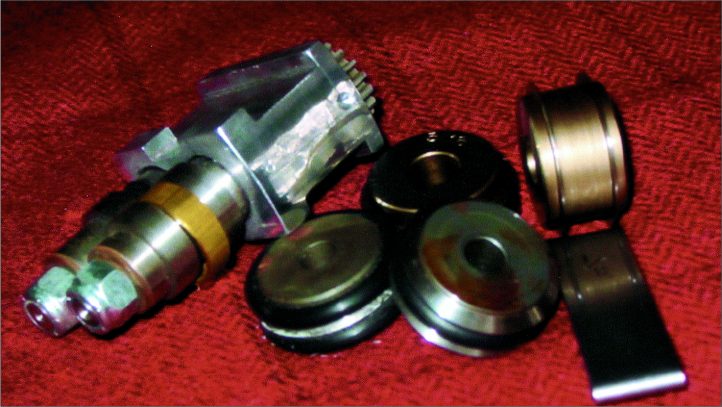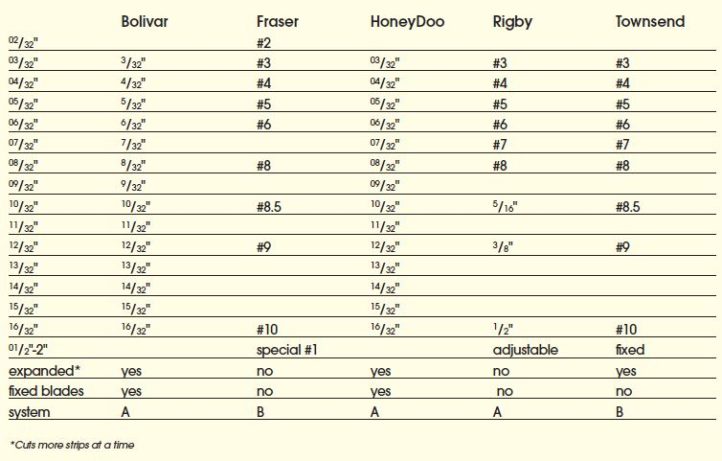
Cutter blades
TEXT AND PHOTOGRAPHY BY CINDY HARTMAN
Are you in the market for a wool cutter or do you already have one and just don’t understand the blades for your machine? Beyond the mechanics of each cutter, there are some differences in blades that are helpful to know.
Shoe Analogy
Last week I went to buy new shoes. (Stick with me, it really does relate.) I asked for my usual size (remember when they use to measure your foot each time?) and the salesman brought out three boxes of shoes. The first pair I tried on were the ones I really wanted, but they were too big. The second pair I tried on were too small and the third pair were just right in length, but too narrow, and I didn’t like them anyway. What’s a woman to do? Well, the salesman brought the first pair out in a smaller size, and they were just right. So now I have a new pair of shoes I just love that fit, but not in my usual shoe size. All three of the original pairs were labeled the same size, but obviously were not the same measurement. Each manufacturer labeled their product differently, or maybe it was the style that made one pair too tight or loose, or perhaps it was the material. The point is, you need to know the numbering system of each to get what you want. And it’s the same with wool cutters.
Cutter blades are measured in 1/32 of an inch. There is a #2 blade, made by the Harry M. Fraser Co., but it is not practical for rugs. It might be used for small pins, or details in fine hooking. A #3 blade is 3/32″, #4 is 4/32″, #5 is 5/32″, etc. up to #8, which is 8/32″, or the reduced fraction of 1/4″. All cutters use the same numbering system up through #8. It is with the larger cuts that things get confusing. From 1/4″ to 1/2″ there are two different systems used to name the blades.
Systems Are Go
Numbering system “A” describes the blades with their true measurement. It uses the number of 1/32 of an inch, or a reduced fraction thereof. In other words, #9 is 9/32″, #10 is 10/32″ or 5/16″, #12 is 12/32″ or 3/4″, and so on. Rigby, Bolivar, and HoneyDoo cutters use this type of system.
Numbering system “B” describes the blades differently—corresponding with when they were ‘invented’ or manufactured. A #9 was the next size made after a #8, and is actually 3/8″, or 12/32″. The next blade to come along was smaller that a #9, so it was named #8.5 and is actually equivalent to System A #5/16, or 10/32″. Fraser and Townsend cutters use this system. (A Bliss cutter uses a Fraser blade, but does not properly cut with anything larger than a #8. You will get a large strip and a very small strip, wasting a lot of wool.)
Are you confused yet? Going around in circles? The following chart will help clarify it for you. Copy it and tuck it into your hooking for easy reference.

To use this chart, find the make of cutter you have at the top. Follow down that column until you get to the size cut you want to use, and where those two columns intersect you will see the proper name for that size cutter blade. For instance, if I have any model Rigby hooking machine, and I want to hook in a 10/32″, I find Rigby at the top of the chart, and follow down until I get to 10/32″ in the column running horizontally, and I find that Rigby calls that blade a #5/16. The fraction is reduced, but it is still the same as 10/32″ in HoneyDoo, and the same as #8.5 in a Fraser or Townsend.
Some of the cutters have fixed blades and some have changeable blades. Some of the fixed blades can be changed. Let me take each type and explain.
Bolivar
The Bolivar Fabric Cutter has fixed blades that come permanently mounted on the machine. It is possible, however, to order a new blade size and get instructions to change it yourself, or send it back to Canada to have them change it. Since Bolivar uses System “A” to name the blades, you need to know the exact 1/32 of an inch you want for all three blades. The Bolivar will cut from five strips of a #3 to three strips of a #8, and two strips of larger cuts, up to #16 (16/32″ or 1/2″). They do have a model that cuts double the number of strips (10 of #3, and six of #8, etc.), for those doing kits. Better yet, in 2005 they will be coming out with a model that has changeable blades.
Fraser
The Fraser Cutter has changeable blades that only fit the Fraser and the Bliss. Remember that the Bliss only takes a blade up to a #8. After #8 the Fraser uses System “B” to number the blades. Their #2 and #3 cut six strips; #4 cuts four; #5 and #6 cut three; #7, #8, #8.5, #9 and #10 cut two strips each. They have a special #1 blade that cuts one strip between 1″ and 2″. To change the blade, loosen the top tension, use the wrench that comes with the machine to loosen the bolt under the machine, pull the blade out, put the new size in, and reassemble.
HoneyDoo
The HoneyDoo Cutter has fixed blades. You need to specify exactly what size you want on the machine when you order. They use System “A” for numbering their machines. They have several models, including ones that cut larger numbers of strips, and ones that are electrified. Besides the Bliss, it is the only model that sits on the table instead of clamping onto it.
Rigby
The Rigby Cloth Stripping Machine has changeable blades. They only fit the Rigby machine, but the same hooking blade will fit any of the hooking models. They use System “A” to number the blades. The different models include one with a single hooking blade, one with two hooking blades, making it easy to switch sizes, and one with one hooking and one braiding blade (for 1/2″ to 2″). Changing the blades is simple: remove the cleaning fingers (clips that keep the wool from wrapping around the wheel), loosen the top tension, remove the screw and washer under the machine, pull the crank arm out and the blades will be released. It’s wise to oil that arm before reassembling. The arm has a notch on it that must line up with the notch on the blade when putting it back together. Make sure the arm is pushed all the way in, and replace the washer and screw. Finally, reinstall the proper finger, to keep the wool from wrapping around the blade. You need a set of the finger and blade for each size.
Townsend
The Townsend Cutter has changeable blades. They are numbered by System “B”. Each blade is a cartridge-like clip that is very easy change. Just flip the arm down, pull out the cartridge and put in the new one, and flip the arm back up. They have expanded blades (cuts more strips with one swipe) for #6 and #8. They also have a new machine that cuts from 1/2″ to 2″. It is a fixed blade, one per machine.
Cutters are an essential tool in rug hooking. The prices vary greatly, but they are all a sizable investment. Each one has its advantages, and you should decide what features are most important to you. It is a tool you will have for a long time.
